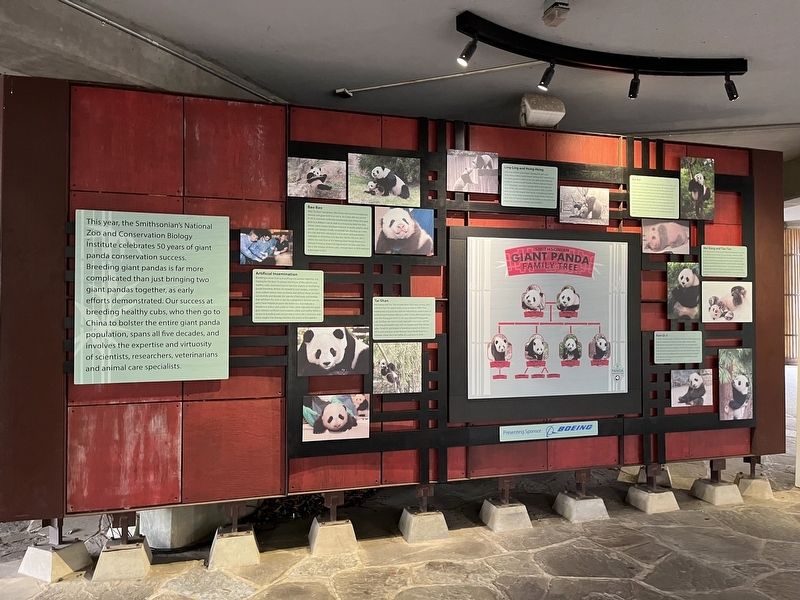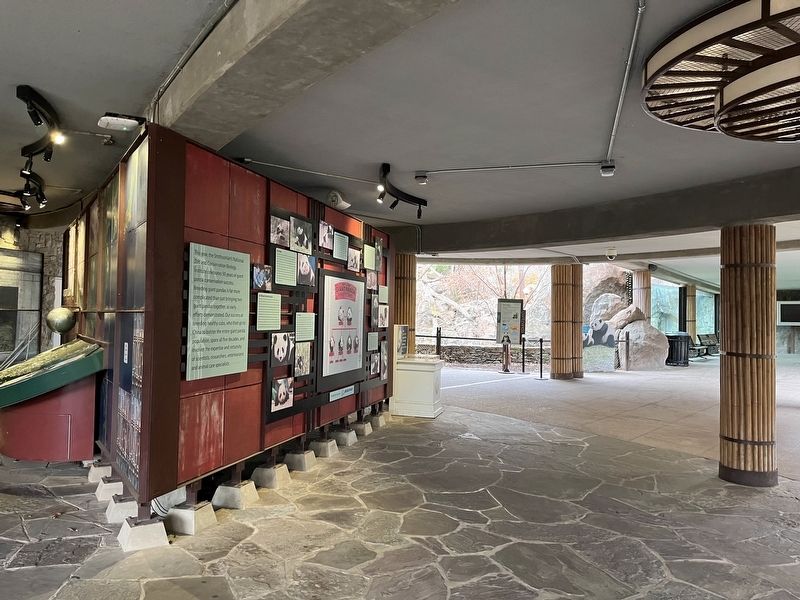Smithsonian National Zoo in Northwest Washington in Washington, District of Columbia — The American Northeast (Mid-Atlantic)
50 Years of Giant Panda Conservation Success

Photographed By Devry Becker Jones (CC0), December 11, 2022
1. 50 Years of Giant Panda Conservation Success Marker
This year, the Smithsonian's National Zoo and Conservation Biology Institute celebrates 50 years of giant panda conservation success. Breeding giant pandas is far more complicated than just bringing two giant pandas together, as early efforts demonstrated. Our success at breeding healthy cubs, who then go to China to bolster the entire giant panda population, spans all five decades, and involves the expertise and virtuosity of scientists, researchers, veterinarians and animal care specialists.
Bao Bao
After Tai Shan had grown, Mei Xiang had several pseudopregnancies and gave birth to a cub in 2012 that did not survive. In 2013, scientists artificially inseminated Mei Xiang who gave birth to a stillborn cub as well as to bouncing baby Bao Bao, whose name means "precious treasure." A sturdy, playful vocal panda cub, keepers fondly remember her climbing up a tree as a cub and then refusing to come down until just before midnight on Christmas Eve! Bao Bao left for China in 2017, where she now lives at the Wolong Giant Panda Reserve in Sichuan Province, where her big brother Tai Shan also lives. She is the mother of three cubs: a female born in 2020 and twin males born in 2021.
Artificial Insemination
Breeding is more than just putting two pandas together and hoping for the best. To ensure the future of the species and healthy cubs, scientists have to become experts in facilitating panda breeding. Before the breeding even begins, scientists must collect semen, learn to freeze and defrost those samples successfully and decode the signals of behavior and biology that tell them the time is ripe for a pregnancy. Animal care experts have helped pinpoint the behaviors that indicate a female is in estrus and ready to mate, while reproductive biologists conduct artificial inseminations safely and swiftly. When it comes to breeding and conservation, every life is precious, and every insight into biology bolsters the status of the species.
Tai Shan
Mei Xiang and Tian Tian arrived when they were young cubs and first had the opportunity to try to mate in 2003. That mating was unsuccessful and was followed by several years of artificial insemination efforts. In 2005, those efforts bore fruit and Mei Xiang gave birth to the Zoo's first surviving panda cub, Tai Shan. His name means "peaceful mountain," and his charming personality won over his keepers and Zoo visitors alike. He left to participate in breeding research in China in 2010, and now lives at the Wolong Giant Panda Reserve in Sichuan, China. He is the father of a cub born in 2020.
Ling-Ling and Hsing-Hsing
Ling-Ling (whose name meant "darling little girl") and Hsing-Hsing

Photographed By Devry Becker Jones (CC0), December 11, 2022
2. 50 Years of Giant Panda Conservation Success Marker
Bei Bei
In the summer of 2015, Mei Xiang gave birth to two male cubs following another artificial insemination. The smaller cub did not survive, but bigger of the two did. The First Lady of the United States and the First Lady of the People's Republic of China, together named the cub Bei Bei, which, like his big sister's, means "precious treasure." A very mellow bear, he napped through his public debut, as well as through his first birthday party, and was only 13 months old when he calmly allowed keepers to draw his blood for a veterinary exam. He left for China in 2019 and now lives at the BifengXia Base in Ya'an.
Mei Xiang and Tian Tian
Mei Xiang (whose name means "beautiful fragrance") and Tian Tian (whose name means "more and more") arrived in 2000. Gentle Mei Xiang and playful Tian Tian are beloved Zoo bears and the parents of a panoply of panda cubs. Studying their behavior and biology has helped scientists better understand panda conservation both in human care and in the wild. As ambassadors for their species, as parents and as charismatic creatures, they are a vital part of the story of giant pandas as a species.
Xiao Qi Ji
In 2020, scientists again artificially inseminated Mei Xiang using frozen-thawed semen from Tian Tian. After a few months, veterinarians were able to see fetal tissue on an ultrasound heralding the birth of a healthy cub later that summer. A public vote chose the name Xiao Qi Ji for the cub, which means "little miracle." A clever, cautious and inquisitive cub, he is an eager participant in training sessions and loves checking out new enrichment and toys.
Erected 2022 by SCBI, Smithsonian Institution.
Topics and series. This historical marker is listed in these topic lists: Animals • Parks & Recreational Areas • Peace • Science & Medicine. In addition, it is included in the Former U.S. Presidents: #37 Richard M. Nixon series list. A significant historical year for this entry is 1972.
Location. 38° 55.833′ N, 77° 3.132′ W. Marker is in Northwest Washington in Washington, District of Columbia. It is in Smithsonian National Zoo. Marker is on Asia Trail south of Olmsted Walk, on the right when traveling east. Touch for map. Marker is at or near this postal address: 3001 Connecticut Ave NW, Washington DC 20008, United States of America. Touch for directions.
Other nearby markers. At least 8 other markers are within walking distance of this marker. Back in Business (a few steps from this marker); Wang Dajun (within shouting distance of this marker); Giant Pandas (within shouting distance of this marker); An Alternative to Logging (within shouting distance of this marker); Zhu Xiaojian (within shouting distance of this marker); Giant Panda (within shouting distance of this marker); a different marker also named Giant Panda (within shouting distance of this marker); An Invasive Fish (within shouting distance of this marker). Touch for a list and map of all markers in Northwest Washington.
Credits. This page was last revised on January 30, 2023. It was originally submitted on December 11, 2022, by Devry Becker Jones of Washington, District of Columbia. This page has been viewed 82 times since then and 12 times this year. Photos: 1, 2. submitted on December 11, 2022, by Devry Becker Jones of Washington, District of Columbia.